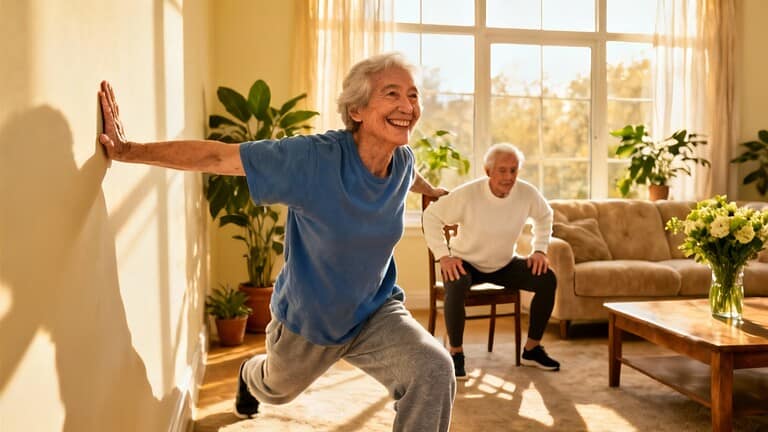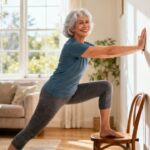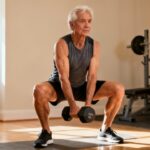If you’ve been relying on daily walks to build muscle and fight sarcopenia, you might be surprised to learn that it’s not enough.
While walking has its benefits, it often fails to provide the resistance needed to truly challenge your muscles and reverse age-related decline.
In this article, we’ll explore two simple home exercises that require no equipment and are backed by scientific studies to help you gain strength and combat muscle loss effectively.
Why Walking Falls Short for Muscle Building
Walking engages about 200 muscles, but only at 20-30% of their capacity. Without real resistance, your muscles aren’t pushed to grow. This gentle movement might maintain health, but it won’t build the muscle needed to fight sarcopenia, the age-related loss of muscle mass. Many seniors make the mistake of over-relying on walking or risky weightlifting, which can lead to injuries.
Wall Push-Ups: Your Upper Body Solution
Wall push-ups activate your chest, shoulders, triceps, and core at 60-70% capacity—triple the engagement of walking. This exercise creates microscopic tears in muscle fibers, which heal stronger and thicker, promoting growth.
A study in the Journal of Aging and Physical Activity found that seniors doing wall push-ups three times weekly gained 31% more upper body strength and 2.3 pounds of lean muscle in 12 weeks.
How to Do Wall Push-Ups Correctly
- Stand facing a wall, about arm’s length away.
- Place palms flat on the wall at shoulder height, fingers up.
- Keep feet hip-width apart and body straight.
- Bend elbows slowly, leaning in until your nose nearly touches the wall.
- Push back to start, breathing in as you lower and out as you push.
- Aim for 8-10 reps per set, with three sets and 1-minute rests.
Do this three times a week, like Monday, Wednesday, and Friday, for best results. Adjust your distance from the wall to make it easier or harder.
Chair Squats: Boost Lower Body Strength
Chair squats target your quadriceps, glutes, hamstrings, and calves at 75-80% capacity, far surpassing walking’s minimal engagement. This exercise triggers growth hormone release, essential for muscle building.
Research involving seniors showed an average gain of 3.7 pounds of leg muscle, 43% faster sit-to-stand times, and halved fall risk after 16 weeks.
How to Perform Chair Squats Safely
- Stand with feet shoulder-width apart in front of a stable chair.
- Extend arms straight out for balance.
- Push hips back and lower slowly as if sitting, until your bottom lightly touches the chair.
- Pause briefly, then drive through your heels to stand up, squeezing glutes.
- Keep chest up and eyes forward throughout.
- Start with 10-12 reps per set, doing three sets with 90-second rests.
Practice this four times a week, such as Monday, Tuesday, Thursday, and Saturday, to allow for recovery.
Exercises to Avoid for Safe Muscle Building
Some common exercises can do more harm than good, especially for seniors. Avoid these to prevent injuries:
- Sit-ups and crunches: They compress the spine and risk back or neck injuries, with studies showing 23% of seniors experience issues severe enough to halt exercise.
- Behind-the-neck shoulder presses: This forces shoulders into unnatural positions, leading to rotator cuff damage; 31% of seniors develop injuries within a year.
- Deep knee extensions on machines: Designed for rehab, they create shearing forces on knees and aren’t suitable for aging joints.
Putting It All Together for Lasting Strength
Combining wall push-ups and chair squats into your routine can help you build muscle, reverse sarcopenia, and maintain independence.
Remember, exercise is only part of the equation—proper nutrition, especially adequate protein, is crucial for muscle growth. Start with these exercises today, focus on consistency, and you’ll be on your way to a stronger, healthier you.








